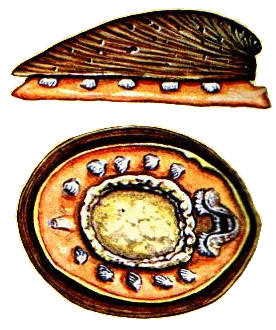(mono-plac-o-phora)
Latin:
mono=one plac=plate phor=carry : bearing
a single single plate (shell)

From " A Guide to Field Identification - Seashells of North America"
-revised edition by Abbott & Sanderström |
Until the mid nineteen hundreds, this class,
often call the "gastroverms", were thought to be extinct
and appeared only in Cambrian fossil records. Then in 1952 scientists
discovered ten living specimens while on the Danish Galathea expedition.
Two years later on the same expedition, two more species were discovered.
Now we recognize about a dozen living species.
These strange, limpet-shaped molluscs are segmented like worms. In each
segment of the creature the internal vital organs are duplicated. They
are indeed primitive in biology and as such tend to live only in the deeper
ocean areas where they are away from the more advanced and active predators.
|
|
|
- Order Cyrtonellida
1987; T=Early Cambrian to Middle Devonian;
- Order Tryblidiida Details
1987; T=Middle Cambrian to Present;
- Order [Tryblidioidea] Order Tryblidiida
Boss, in Parker,1982:
- Order [Bellerophontida]
- Superfamily †Bellerophontoidea
Ref=(o)1987; T=Middle Cambrian to Early Triassic
- Order Pelagiellida
1987; T=Early Cambrian to Late Cambrian;
|
|
|
Monoplacophorans possess a single, large, bilateral
shell. The shell is a simple depressed limpet or disk -shaped valve, less
than 25 millimeters across usually and is often thin and fragile. The earliest
developed part is a coiled chamber. The outer surface of the adult is covered
with a protective horny periostracum,
or sheath. On the inner surface of the shell, there are significant paired muscle
scars, suggesting segmentation.
Monoplacophorans possess a foot, round in outline
and not very muscular, which is responsible for locomotion. The
muscular action is similar to that of the polyplacophorans. (Please refer
to the Polyplacophora for info on this.).
Running along the mantle gutter cavity
on either side of the body are five or six pairs of gills, however, filaments
only exist on one side of the gill axis.
Monoplacophorans possess a single ventricle and
two auricles for circulating the blood per body segment. The first pair
of auricles receives the blood from the first four pair of gills. The
pericardium is paired and the heart lies between the two divisions.
The head of Monoplacophorans is much reduced in
size lacks true eyes and tentacles.
The nervous system of this class is very similar to that of the Polyplacophorans.
(Please refer to the data on Polyplacophora for that information!).
The digestive system is very similar to that of
the gastropods. (Please refer to that data for details).
The difference is that behind the mouth is a curious cluster of frond-like appendages
that serve to push the food into the pharynx. Also the mouth is located
in front of the foot and the anus is located posteriorly in the pallial groove.
From the nature of their radula ribbon of teeth, it can be postulated
that they ingest mud or bottom detritus.
The radula is actually upside down as compared to the radula of other
molluscs.
Six pair of nephridia are
present and are arranged in series (metamerically) on each side of the body.
The nephridiopores of the last five pair open near the five-gill pairs.
The sexes are separate, and two pair of gonads
are located in the middle of the body. Each gonad is connected by a duct
to one of the two pairs of nephridia (kidneys), which are located in the middle
of the body.
There is SO MUCH still to be learned about these
inhabitants of the deep, and if you become a marine biologist, some day you
could be the one to shed light into some of the darker corners or our knowledge
of these and other little-studied taxa!
